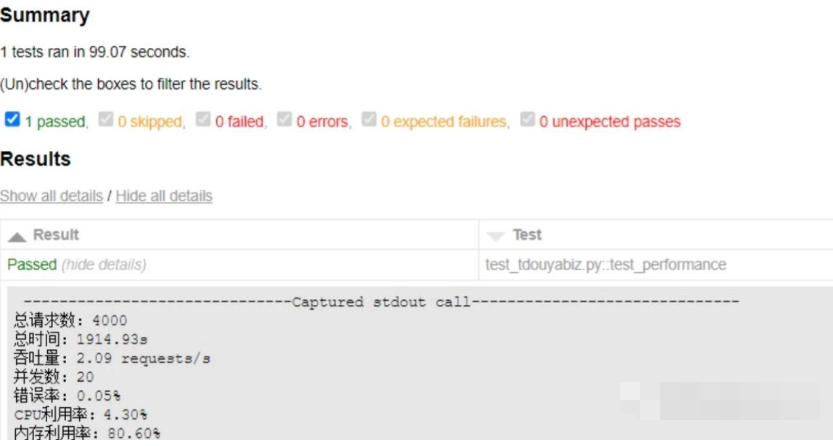
在现代Web应用程序中,性能是至关重要的。为了确保应用程序能够在高负载下正常运行,我们需要进行性能测试。本文就来用Pytest进行压力测试,希望对大家有所帮助
在现代Web应用程序中,性能是至关重要的。为了确保应用程序能够在高负载下正常运行,我们需要进行性能测试。 今天,应小伙伴的提问, 田辛老师来写一个Pytest进行压力测试的简单案例。 这个案例的测试网站我们就隐藏了,不过网站的基本情况是:
-
阿里
-
框架:FastAdmin.net
1.程序说明
1.1 设置测试参数
首先,做的第一件事情就是设置测试参数。代码如下
# 定义测试用例
def test_performance():
# 设置测试参数
url = 'http://www.a.com/'
num_threads = 20
num_requests = 200
timeout = 5
设置网站的URL, 线程数, 每个线程的请求次数,以及超时时间。 可以看到一共会做4000次请求。
1.2 初始化测试结果
这段代码, 这里做一个提示:注意缩进, 这段代码仍然在测试用例test_performance内。
# 初始化测试结果
response_times = []
errors = 0
successes = 0
1.3 定义测试函数
接下来, 定义一个内部函数。这个函数就是在某一线程内完成设定次数的请求。
# 定义测试函数 def test_func(): nonlocal errors, successes for _ in range(num_requests): try: start_time = time.time() requests.get(url, timeout=timeout) end_time = time.time() response_time = end_time - start_time response_times.append(response_time) successes += 1 except requests.exceptions.RequestException: errors += 1
1.4 创建线程、执行线程、等待
# 创建测试线程
threads = []
for _ in range(num_threads):
t = threading.Thread(target=test_func)
threads.append(t)
# 启动测试线程
for t in threads:
t.start()
# 等待测试线程结束
for t in threads:
t.join()
1.5 计算测试结果
# 计算测试结果
total_requests = num_threads * num_requests
throughput = successes / (sum(response_times) or 1)
concurrency = num_threads
error_rate = errors / (total_requests or 1)
cpu_usage = psutil.cpu_percent()
memory_usage = psutil.virtual_memory().percent
1.6 将测试结果写入文件
# 将测试结果写入文件
with open('performance_test_result.txt', 'w') as f:
f.write(f'总请求数:{total_requests}\n')
f.write(f'总时间:{sum(response_times):.2f}s\n')
f.write(f'吞吐量:{throughput:.2f} requests/s\n')
f.write(f'并发数:{concurrency}\n')
f.write(f'错误率:{error_rate:.2%}\n')
f.write(f'CPU利用率:{cpu_usage:.2f}%\n')
f.write(f'内存利用率:{memory_usage:.2f}%\n')
2.程序执行
2.1 直接执行
在PyCharm里面直接执行这段代码, 得出的结果是:
总请求数:4000 总时间:1837.65s 吞吐量:2.17 requests/s 并发数:20 错误率:0.12% CPU利用率:4.10% 内存利用率:88.60%
2.2 加个装饰器然后出报告
如果在PyCharm里面直接执行上面的代码, 虽然我们把结果写在文件中,但是, 不好看呀。
额外介绍一个方法,这个方法能够生成一个相对美观的测试报告出来。
2.2.1 声明压力测试
首先在定义用例的时候通过装饰器声明这是一个压力测试:
定义测试用例
@pytest.mark.performance
def test_performance():
# 设置测试参数
url = 'http://www.a.biz/'
num_threads = 20
2.2.2 在命令行中通过pytest命令执行测试
第二步, 在命令行中执行测试
-v 用于显示详细的测试结果
–html 用于指定输出报告的位置。 这个参数需要依赖包:pytest-html
$ pytest -v --html=report.html test_a.py
输出执行结果是:
======================== test session starts =================================platform win32 -- Python 3.10.9, pytest-7.2.1, pluggy-1.0.0 -- D:\python-grp\miniconda_env\py3.10_playwright\python.execachedir: .pytest_cachemetadata: {'Python': '3.10.9', 'Platform': 'Windows-10-10.0.22624-SP0', 'Packages': {'pytest': '7.2.1', 'pluggy': '1.0.0'}, 'Plugins': {'allure-pytest': '2.12.0', 'base-url': '2.0.0', 'html': '3.2.0', 'metadata': '2.0.4', 'ordering': '0.6', 'playwright': '0.3.0'}, 'JAVA_HOME': 'D:\\java-grp\\jdk\\', 'Base URL': ''}rootdir: E:\develop\python\pytest-training\testplugins: allure-pytest-2.12.0, base-url-2.0.0, html-3.2.0, metadata-2.0.4, ordering-0.6, playwright-0.3.0collected 1 item test_a.py::test_performance PASSED [100%]========================== warnings summary ================================= test_a.py:25 E:\develop\python\pytest-training\test\test_a.py:25: PytestUnknownMarkWarning: Unknown pytest.mark.performance - is this a typo? You can register custom marks to avoid this warning - for details, see https://docs.pytest.org/en/stable/how-to/mark.html @pytest.mark.performance-- Docs: https://docs.pytest.org/en/stable/how-to/capture-warnings.html-- generated html file: file:///E:/develop/python/pytest-training/test/report.html -- ================= 1 passed, 1 warning in 99.09s (0:01:39) =================== (D:\python-grp\miniconda_env\py3.10_playwright) E:\develop\python\pytest-training\test>
最终生成的报告是:(截取了关键部分)

3.案例缺陷
因为时间关系, 本案例今天没有时间在服务器端执行, 所以通过psutil库所取得CPU利用率和内存利用率时间并不对。 如果是在服务器端执行, 这两个数字才是对的。
如果要在本地获取服务器的CPU,内存,IO等情况,有一个监控神器:Prometheus。不过这东西配置起来又是另一个话题。
4 完整源码
# 压力测试案例
import threading
import time
import psutil
import pytest
import requests
# 定义测试用例
@pytest.mark.performance
def test_performance():
# 设置测试参数
url = 'http://www.tdouya.biz/'
num_threads = 20
num_requests = 200
timeout = 5
# 初始化测试结果
response_times = []
errors = 0
successes = 0
# 定义测试函数
def test_func():
nonlocal errors, successes
for _ in range(num_requests):
try:
start_time = time.time()
requests.get(url, timeout=timeout)
end_time = time.time()
response_time = end_time - start_time
response_times.append(response_time)
successes += 1
except requests.exceptions.RequestException:
errors += 1
# 创建测试线程
threads = []
for _ in range(num_threads):
t = threading.Thread(target=test_func)
threads.append(t)
# 启动测试线程
for t in threads:
t.start()
# 等待测试线程结束
for t in threads:
t.join()
# 计算测试结果
total_requests = num_threads * num_requests
throughput = successes / (sum(response_times) or 1)
concurrency = num_threads
error_rate = errors / (total_requests or 1)
cpu_usage = psutil.cpu_percent()
memory_usage = psutil.virtual_memory().percent
# 输出测试结果
print(f'总请求数:{total_requests}')
print(f'总时间:{sum(response_times):.2f}s')
print(f'吞吐量:{throughput:.2f} requests/s')
print(f'并发数:{concurrency}')
print(f'错误率:{error_rate:.2%}')
print(f'CPU利用率:{cpu_usage:.2f}%')
print(f'内存利用率:{memory_usage:.2f}%')
# 将测试结果写入文件
with open('performance_test_result.txt', 'w') as f:
f.write(f'总请求数:{total_requests}\n')
f.write(f'总时间:{sum(response_times):.2f}s\n')
f.write(f'吞吐量:{throughput:.2f} requests/s\n')
f.write(f'并发数:{concurrency}\n')
f.write(f'错误率:{error_rate:.2%}\n')
f.write(f'CPU利用率:{cpu_usage:.2f}%\n')
f.write(f'内存利用率:{memory_usage:.2f}%\n')
到此这篇关于Python+Pytest实现压力测试详解的文章就介绍到这了。
最后
如果你想学习自动化测试,那么下面这套视频应该会帮到你很多
如何逼自己1个月学完自动化测试,学完即就业,小白也能信手拈来,拿走不谢,允许白嫖....
最后我这里给你们分享一下我所积累和整理的一些文档和学习资料,有需要直接领取就可以了!

以上内容,对于软件测试的朋友来说应该是最全面最完整的备战仓库了,为了更好地整理每个模块,我也参考了很多网上的优质博文和项目,力求不漏掉每一个知识点,很多朋友靠着这些内容进行复习,拿到了BATJ等大厂的offer,这个仓库也已经帮助了很多的软件测试的学习者,希望也能帮助到你。






















 2669
2669











 被折叠的 条评论
为什么被折叠?
被折叠的 条评论
为什么被折叠?








